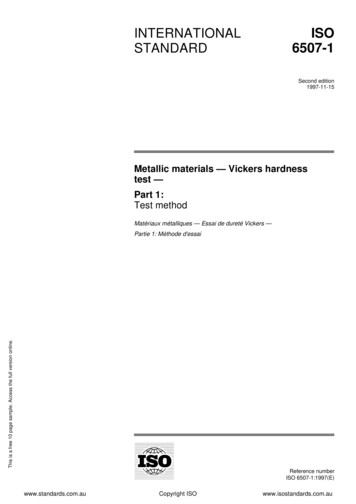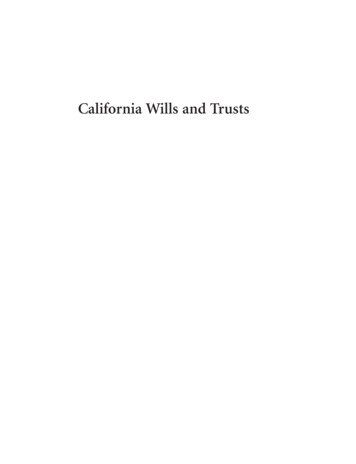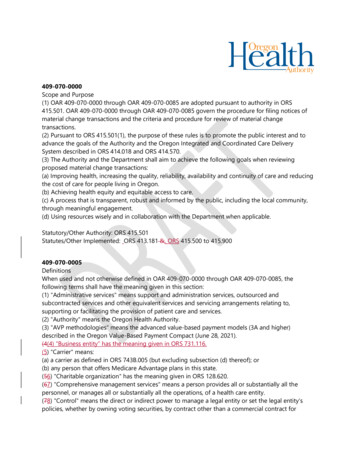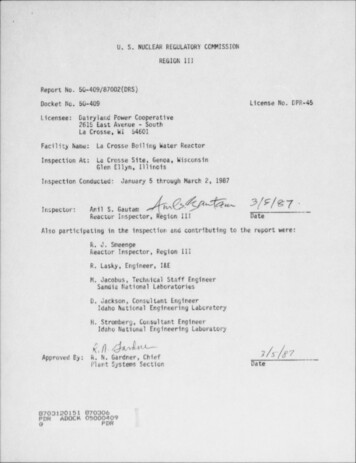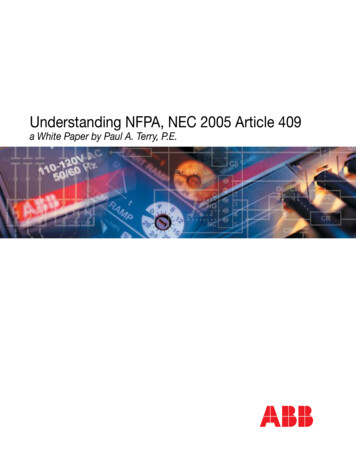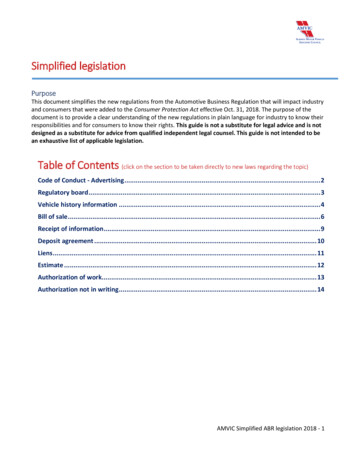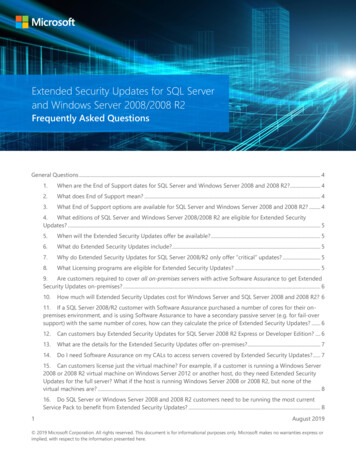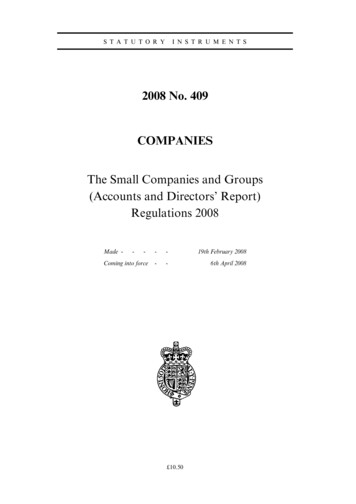
Transcription
S T A T U T O R YI N S T R U M E N T S2008 No. 409COMPANIESThe Small Companies and Groups(Accounts and Directors’ Report)Regulations 2008Made ---Coming into force--19th February 2008--6th April 2008 10.50
STATUTORY INSTRUMENTS2008 No. 409COMPANIESThe Small Companies and Groups (Accounts and Directors’Report) Regulations 2008Made----19th February 2008Coming into force --6th April 2008CONTENTSPART 1INTRODUCTION1.2.Citation and interpretationCommencement and applicationPART 2FORM AND CONTENT OF INDIVIDUAL ACCOUNTS3.4.5.6.Companies Act individual accountsInformation about related undertakings (Companies Act or IAS individualaccounts)Information about directors’ benefits: remuneration (Companies Act or IASindividual accounts)Accounts for delivery to registrar of companies (Companies Act individualaccounts)PART 3DIRECTORS’ REPORT7.Directors’ reportPART 4FORM AND CONTENT OF GROUP ACCOUNTS8.9.10.11.Companies Act group accountsInformation about directors’ benefits: remuneration (Companies Act or IAS groupaccounts)Information about related undertakings (Companies Act or IAS group accounts)Accounts for delivery to registrar of companies (Companies Act group accounts)
PART 5INTERPRETATION12.13.Definition of “provisions”General interpretationSCHEDULE 1PART 1PART 2PART 3SCHEDULE 2—————PART 1 —PART 2 —SCHEDULE 3 —PART 1 —PART 2 —SCHEDULE 4 —PART 1PART 2SCHEDULE 5SCHEDULE 6PART 1—————PART 2 —SCHEDULE 7 —PART 1 —PART 2 —SCHEDULE 8 —COMPANIES ACT INDIVIDUAL ACCOUNTSGENERAL RULES AND FORMATSACCOUNTING PRINCIPLES AND RULESNOTES TO THE ACCOUNTSINFORMATION ABOUT RELATED UNDERTAKINGSWHERE COMPANY NOT PREPARING GROUPACCOUNTS (COMPANIES ACT OR IAS INDIVIDUALACCOUNTS)REQUIRED DISCLOSURESINTERPRETATION OF REFERENCES TO “BENEFICIALINTEREST”INFORMATION ABOUT DIRECTORS’ BENEFITS:REMUNERATION (COMPANIES ACT OR IASACCOUNTS)INFORMATION REQUIRED TO BE DISCLOSEDSUPPLEMENTARY PROVISIONSCOMPANIES ACT ABBREVIATED ACCOUNTS FORDELIVERY TO REGISTRAR OF COMPANIESTHE REQUIRED BALANCE SHEET FORMATSNOTES TO THE ACCOUNTSMATTERS TO BE DEALT WITH IN DIRECTORS’ REPORTGROUP ACCOUNTSFORM AND CONTENT OF COMPANIES ACT GROUPACCOUNTSINFORMATION ABOUT RELATED UNDERTAKINGSWHERE COMPANY PREPARING GROUP ACCOUNTS(COMPANIES ACT OR IAS GROUP ACCOUNTS)INTERPRETATION OF TERM “PROVISIONS”MEANING FOR PURPOSES OF THESE REGULATIONSMEANING FOR PURPOSES OF PARTS 18 AND 23 OF THE2006 ACTGENERAL INTERPRETATIONThe Secretary of State makes the following Regulations in exercise of the powers conferred bysections 396(3), 404(3), 409(1) to (3), 412(1) to (3), 416(4), 444(3)(a) and (b), 677(3)(a),712(2)(b)(i), 836(1)(b)(i) and 1292(1)(a) and (c) of the Companies Act 2006(a).In accordance with sections 473(3) and 1290 of the Companies Act 2006 a draft of this instrumentwas laid before Parliament and approved by a resolution of each House of Parliament.(a) 2006 c.46.2
PART 1INTRODUCTIONCitation and interpretation1.—(1) These Regulations may be cited as the Small Companies and Groups (Accounts andDirectors’ Report) Regulations 2008.(2) In these Regulations “the 2006 Act” means the Companies Act 2006.Commencement and application2.—(1) These Regulations come into force on 6th April 2008.(2) They apply in relation to financial years beginning on or after 6th April 2008.(3) They apply to companies which are subject to the small companies regime under Part 15 ofthe 2006 Act (see section 381 of that Act(a)).PART 2FORM AND CONTENT OF INDIVIDUAL ACCOUNTSCompanies Act individual accounts3.—(1) Companies Act individual accounts under section 396 of the 2006 Act (Companies Act:individual accounts) must comply with the provisions of Schedule 1 to these Regulations as to theform and content of the balance sheet and profit and loss account, and additional information to beprovided by way of notes to the accounts.(2) The profit and loss account of a company that falls within section 408 of the 2006 Act(individual profit and loss account where group accounts prepared)(b) need not contain theinformation specified in paragraphs 59 to 61 of Schedule 1 to these Regulations (informationsupplementing the profit and loss account).(3) Accounts are treated as having complied with any provision of Schedule 1 to theseRegulations if they comply instead with the corresponding provision of Schedule 1 to the Largeand Medium-Sized Companies and Groups (Accounts and Reports) Regulations 2008(c).Information about related undertakings (Companies Act or IAS individual accounts)4.—(1) Companies Act or IAS individual accounts must comply with the provisions of Schedule2 to these Regulations as to information about related undertakings to be given in notes to thecompany’s accounts.(2) Information otherwise required to be given by Schedule 2 to these Regulations need not bedisclosed with respect to an undertaking that—(a) is established under the law of a country outside the United Kingdom, or(b) carries on business outside the United Kingdom,if the conditions specified in section 409(4) of the 2006 Act are met (see section 409(5) of the2006 Act for disclosure required where advantage taken of this exemption).This paragraph does not apply in relation to the information required by paragraphs 4 and 8 ofSchedule 2 to these Regulations.(a) Section 381 is amended by regulation 6(1) of S.I. 2008/393.(b) Section 408 is amended by regulation 10 of S.I. 2008/393.(c) S.I. 2008/410.3
Information about directors’ benefits: remuneration (Companies Act or IAS individualaccounts)5. Companies Act or IAS individual accounts must comply with the provisions of Schedule 3 tothese Regulations as to information about directors’ remuneration to be given in notes to thecompany’s accounts.Accounts for delivery to registrar of companies (Companies Act individual accounts)6.—(1) The directors of a company for which they are preparing Companies Act individualaccounts may deliver to the registrar of companies under section 444 of the 2006 Act (filingobligations of companies subject to small companies regime) a copy of a balance sheet whichcomplies with Schedule 4 to these Regulations rather than Schedule 1.(2) Companies Act individual accounts delivered to the registrar need not give the informationrequired by—(a) paragraph 4 of Schedule 2 to these Regulations (shares of company held by subsidiaryundertakings), or(b) Schedule 3 to these Regulations (directors’ benefits).PART 3DIRECTORS’ REPORTDirectors’ report7. The report which the directors of a company are required to prepare under section 415 of the2006 Act (duty to prepare directors’ report) must disclose the matters specified in Schedule 5 tothese Regulations.PART 4FORM AND CONTENT OF GROUP ACCOUNTSCompanies Act group accounts8.—(1) Where the directors of a parent company which—(a) is subject to the small companies regime, and(b) has prepared Companies Act individual accounts in accordance with regulation 3,prepare Companies Act group accounts under section 398 of the 2006 Act (option to preparegroup accounts), those accounts must comply with the provisions of Part 1 of Schedule 6 to theseRegulations as to the form and content of the consolidated balance sheet and consolidated profitand loss account, and additional information to be provided by way of notes to the accounts.(2) Accounts are treated as having complied with any provision of Part 1 of Schedule 6 if theycomply instead with the corresponding provision of Schedule 6 to the Large and Medium-SizedCompanies and Groups (Accounts and Reports) Regulations 2008.Information about directors’ benefits: remuneration (Companies Act or IAS groupaccounts)9. Companies Act or IAS group accounts must comply with the provisions of Schedule 3 tothese Regulations as to information about directors’ remuneration to be given in notes to thecompany’s accounts.4
Information about related undertakings (Companies Act or IAS group accounts)10.—(1) Companies Act or IAS group accounts must comply with the provisions of Part 2 ofSchedule 6 to these Regulations as to information about related undertakings to be given in notesto the company’s accounts.(2) Information otherwise required to be given by Part 2 of Schedule 6 need not be disclosedwith respect to an undertaking that—(a) is established under the law of a country outside the United Kingdom, or(b) carries on business outside the United Kingdom,if the conditions specified in section 409(4) of the 2006 Act are met (see section 409(5) of the2006 Act for disclosure required where advantage taken of this exemption).This paragraph does not apply in relation to the information required by paragraphs 26 and 35 ofSchedule 6 to these Regulations.Accounts for delivery to registrar of companies (Companies Act group accounts)11. Companies Act group accounts delivered to the registrar of companies under section 444 ofthe 2006 Act need not give the information required by—(a) Schedule 3 to these Regulations (directors’ benefits), or(b) paragraph 25 of Schedule 6 to these Regulations (shares of company held by subsidiaryundertakings).PART 5INTERPRETATIONDefinition of “provisions”12. Schedule 7 to these Regulations defines “provisions” for the purpose of these Regulationsand for the purposes of—(a) section 677(3)(a) (Companies Act accounts: relevant provisions for purposes of financialassistance) in Part 18 of the 2006 Act,(b) section 712(2)(b)(i) (Companies Act accounts: relevant provisions to determine availableprofits for redemption or purchase by private company out of capital) in that Part, and(c) section 836(1)(b)(i) (Companies Act accounts: relevant provisions for distributionpurposes) in Part 23 of that Act.General interpretation13. Schedule 8 to these Regulations contains general definitions for the purposes of theseRegulations.19th February 2008Gareth ThomasParliamentary Under Secretary of State for Trade and Consumer Affairs,Department for Business, Enterprise and Regulatory Reform5
SCHEDULE 1Regulation 3(1)COMPANIES ACT INDIVIDUAL ACCOUNTSPART 1GENERAL RULES AND FORMATSSECTION AGENERAL RULES1.—(1) Subject to the following provisions of this Schedule—(a) every balance sheet of a company must show the items listed in either of the balancesheet formats in Section B of this Part, and(b) every profit and loss account must show the items listed in any one of the profit and lossaccount formats in Section B.(2) References in this Schedule to the items listed in any of the formats in Section B are to thoseitems read together with any of the notes following the formats which apply to those items.(3) The items must be shown in the order and under the headings and sub-headings given in theparticular format used, but—(a) the notes to the formats may permit alternative positions for any particular items, and(b) the heading or sub-heading for any item does not have to be distinguished by any letter ornumber assigned to that item in the format used.2.—(1) Where in accordance with paragraph 1 a company’s balance sheet or profit and lossaccount for any financial year has been prepared by reference to one of the formats in Section B,the company’s directors must use the same format in preparing Companies Act individualaccounts for subsequent financial years, unless in their opinion there are special reasons for achange.(2) Particulars of any such change must be given in a note to the accounts in which the newformat is first used, and the reasons for the change must be explained.3.—(1) Any item required to be shown in a company’s balance sheet or profit and loss accountmay be shown in greater detail than required by the particular format used.(2) The balance sheet or profit and loss account may include an item representing or coveringthe amount of any asset or liability, income or expenditure not otherwise covered by any of theitems listed in the format used, save that none of the following may be treated as assets in anybalance sheet—(a) preliminary expenses,(b) expenses of, and commission on, any issue of shares or debentures,(c) costs of research.4.—(1) Where the special nature of the company’s business requires it, the company’s directorsmust adapt the arrangement, headings and sub-headings otherwise required in respect of itemsgiven an Arabic number in the balance sheet or profit and loss account format used.(2) The directors may combine items to which Arabic numbers are given in any of the formatsset out in Section B if—(a) their individual amounts are not material to assessing the state of affairs or profit or lossof the company for the financial year in question, or(b) the combination facilitates that assessment.6
(3) Where sub-paragraph (2)(b) applies, the individual amounts of any items which have beencombined must be disclosed in a note to the accounts.5.—(1) Subject to sub-paragraph (2), the directors must not include a heading or sub-headingcorresponding to an item in the balance sheet or profit and loss account format used if there is noamount to be shown for that item for the financial year to which the balance sheet or profit andloss account relates.(2) Where an amount can be shown for the item in question for the immediately precedingfinancial year that amount must be shown under the heading or sub-heading required by the formatfor that item.6. Every profit and loss account must show the amount of a company’s profit or loss on ordinaryactivities before taxation.7.—(1) For every item shown in the balance sheet or profit and loss account the correspondingamount for the immediately preceding financial year must also be shown.(2) Where that corresponding amount is not comparable with the amount to be shown for theitem in question in respect of the financial year to which the balance sheet or profit and lossaccount relates, the former amount may be adjusted, and particulars of the non-comparability andof any adjustment must be disclosed in a note to the accounts.8. Amounts in respect of items representing assets or income may not be set off against amountsin respect of items representing liabilities or expenditure (as the case may be), or vice versa.9. The company’s directors must, in determining how amounts are presented within items in theprofit and loss account and balance sheet, have regard to the substance of the reported transactionor arrangement, in accordance with generally accepted accounting principles or practice.SECTION BTHE REQUIRED FORMATS FOR ACCOUNTS(a)Balance sheet formatsFormat 1A.Called up share capital not paid (1)B.Fixed assetsI. Intangible assets1. Goodwill (2)2. Other intangible assets (3)II. Tangible assets1. Land and buildings2. Plant and machinery etc.III. Investments1. Shares in group undertakings and participating interests2. Loans to group undertakings and undertakings in which the company has aparticipating interest3. Other investments other than loans4. Other investments (4)C.Current assetsI. Stocks(a) A number in brackets following any item is a reference to the note of that number in the notes following the formats.7
II.III.IV.1. Stocks2. Payments on accountDebtors (5)1. Trade debtors2. Amounts owed by group undertakings and undertakings in which the companyhas a participating interest3. Other debtors (1)Investments1. Shares in group undertakings2. Other investments (4)Cash at bank and in handD.Prepayments and accrued income (6)E.Creditors: amounts falling due within one year1. Bank loans and overdrafts2. Trade creditors3. Amounts owed to group undertakings and undertakings in which the companyhas a participating interest4. Other creditors (7)F.Net current assets (liabilities) (8)G.Total assets less current liabilitiesH.Creditors: amounts falling due after more than one year1. Bank loans and overdrafts2. Trade creditors3. Amounts owed to group undertakings and undertakings in which the companyhas a participating interest4. Other creditors (7)I.Provisions for liabilitiesJ.Accruals and deferred income (7)K.Capital and reservesI. Called up share capital (9)II. Share premium accountIII. Revaluation reserveIV. Other reservesV. Profit and loss accountBalance sheet formatsFormat 2ASSETSA.Called up share capital not paid (1)B.Fixed assetsI. Intangible assets8
II.III.1. Goodwill (2)2. Other intangible assets (3)Tangible assets1. Land and buildings2. Plant and machinery etc.Investments1. Shares in group undertakings and participating interests2. Loans to group undertakings and undertakings in which the company has aparticipating interest3. Other investments other than loans4. Other investments (4)C.Current assetsI. Stocks1. Stocks2. Payments on accountII. Debtors (5)1. Trade debtors2. Amounts owed by group undertakings and undertakings in which the companyhas a participating interest3. Other debtors (1)III. Investments1. Shares in group undertakings2. Other investments (4)IV. Cash at bank and in handD.Prepayments and accrued income (6)LIABILITIESA.Capital and reservesI. Called up share capital (9)II. Share premium accountIII. Revaluation reserveIV. Other reservesV. Profit and loss accountB.Provisions for liabilitiesC.Creditors (10)1. Bank loans and overdrafts2. Trade creditors3. Amounts owed to group undertakings and undertakings in which the companyhas a participating interest4. Other creditors (7)D.Accruals and deferred income (7)Notes on the balance sheet formats(1)Called up share capital not paid(Formats 1 and 2, items A and C.II.3.)9
This item may either be shown at item A or included under item C.II.3 in Format 1 or 2.(2)Goodwill(Formats 1 and 2, item B.I.1.)Amounts representing goodwill must only be included to the extent that the goodwill wasacquired for valuable consideration.(3)Other intangible assets(Formats 1 and 2, item B.I.2.)Amounts in respect of concessions, patents, licences, trade marks and similar rights and assetsmust only be included in a company’s balance sheet under this item if either—(a) the assets were acquired for valuable consideration and are not required to be shownunder goodwill, or(b) the assets in question were created by the company itself.(4)Others: Other investments(Formats 1 and 2, items B.III.4 and C.III.2.)Where amounts in respect of own shares held are included under either of these items, thenominal value of such shares must be shown separately.(5)Debtors(Formats 1 and 2, items C.II.1 to 3.)The amount falling due after more than one year must be shown separately for each itemincluded under debtors unless the aggregate amount of debtors falling due after more than oneyear is disclosed in the notes to the accounts.(6)Prepayments and accrued income(Formats 1 and 2, item D.)This item may alternatively be included under item C.II.3 in Format 1 or 2.(7)Other creditors(Format 1, items E.4, H.4 and J and Format 2, items C.4 and D.)There must be shown separately—(a) the amount of any convertible loans, and(b) the amount for creditors in respect of taxation and social security.Payments received on account of orders must be included in so far as they are not shown asdeductions from stocks.In Format 1, accruals and deferred income may be shown under item J or included under itemE.4 or H.4, or both (as the case may require). In Format 2, accruals and deferred income may beshown under item D or within item C.4 under Liabilities.(8)Net current assets (liabilities)(Format 1, item F.)In determining the amount to be shown under this item any prepayments and accrued incomemust be taken into account wherever shown.10
(9)Called up share capital(Format 1, item K.I and Format 2, Liabilities item A.I.)The amount of allotted share capital and the amount of called up share capital which has beenpaid up must be shown separately.(10)Creditors(Format 2, Liabilities items C.1 to 4.)Amounts falling due within one year and after one year must be shown separately for each ofthese items and for the aggregate of all of these items unless the aggregate amount of creditorsfalling due within one year and the aggregate amount of creditors falling due after more than oneyear is disclosed in the notes to the accounts.Profit and loss account formatsFormat 1(see note (14) below)1.Turnover2.Cost of sales (11)3.Gross profit or loss4.Distribution costs (11)5.Administrative expenses (11)6.Other operating income7.Income from shares in group undertakings8.Income from participating interests9.Income from other fixed asset investments (12)10.Other interest receivable and similar income (12)11.Amounts written off investments12.Interest payable and similar charges (13)13.Tax on profit or loss on ordinary activities14.Profit or loss on ordinary activities after taxation15.Extraordinary income16.Extraordinary charges17.Extraordinary profit or loss11
18.Tax on extraordinary profit or loss19.Other taxes not shown under the above items20.Profit or loss for the financial yearProfit and loss account formatsFormat 21.Turnover2.Change in stocks of finished goods and in work in progress3.Own work capitalised4.Other operating income5.6.7.(a)(b)Raw materials and consumablesOther external chargesStaff costs(a) wages and salaries(b) social security costs(c) other pension costs(a)(b)Depreciation and other amounts written off tangible and intangible fixed assetsExceptional amounts written off current assets8.Other operating charges9.Income from shares in group undertakings10.Income from participating interests11.Income from other fixed asset investments (12)12.Other interest receivable and similar income (12)13.Amounts written off investments14.Interest payable and similar charges (13)15.Tax on profit or loss on ordinary activities16.Profit or loss on ordinary activities after taxation17.Extraordinary income18.Extraordinary charges19.Extraordinary profit or loss12
20.Tax on extraordinary profit or loss21.Other taxes not shown under the above items22.Profit or loss for the financial yearProfit and loss account formatsFormat 3(see note (14) below)A.B.Charges1.Cost of sales (11)2.Distribution costs (11)3.Administrative expenses (11)4.Amounts written off investments5.Interest payable and similar charges (13)6.Tax on profit or loss on ordinary activities7.Profit or loss on ordinary activities after taxation8.Extraordinary charges9.Tax on extraordinary profit or loss10.Other taxes not shown under the above items11.Profit or loss for the financial yearIncome1.Turnover2.Other operating income3.Income from shares in group undertakings4.Income from participating interests5.Income from other fixed asset investments (12)6.Other interest receivable and similar income (12)7.Profit or loss on ordinary activities after taxation8.Extraordinary income13
9.Profit or loss for the financial yearProfit and loss account formatsFormat 4A.Charges1.Reduction in stocks of finished goods and in work in progress2.3.(a)(b)Staff costs(a) wages and salaries(b) social security costs(c) other pension costs4.B.Raw materials and consumablesOther external charges(a)(b)Depreciation and other amounts written off tangible and intangible fixed assetsExceptional amounts written off current assets5.Other operating charges6.Amounts written off investments7.Interest payable and similar charges (13)8.Tax on profit or loss on ordinary activities9.Profit or loss on ordinary activities after taxation10.Extraordinary charges11.Tax on extraordinary profit or loss12.Other taxes not shown under the above items13.Profit or loss for the financial yearIncome1.Turnover2.Increase in stocks of finished goods and in work in progress3.Own work capitalised4.Other operating income5.Income from shares in group undertakings6.Income from participating interests14
7.Income from other fixed asset investments (12)8.Other interest receivable and similar income (12)9.Profit or loss on ordinary activities after taxation10.Extraordinary income11.Profit or loss for the financial yearNotes on the profit and loss account formats(11)Cost of sales: distribution costs: administrative expenses(Format 1, items 2, 4 and 5 and Format 3, items A.1, 2 and 3.)These items must be stated after taking into account any necessary provisions for depreciation ordiminution in value of assets.(12)Income from other fixed asset investments: other interest receivable and similar income(Format 1, items 9 and 10; Format 2, items 11 and 12; Format 3, items B.5 and 6 and Format 4,items B.7 and 8.)Income and interest derived from group undertakings must be shown separately from incomeand interest derived from other sources.(13)Interest payable and similar charges(Format 1, item 12; Format 2, item 14; Format 3, item A.5 and Format 4, item A.7.)The amount payable to group undertakings must be shown separately.(14)Formats 1 and 3The amount of any provisions for depreciation and diminution in value of tangible andintangible fixed assets falling to be shown under items 7(a) and A.4(a) respectively in Formats 2and 4 must be disclosed in a note to the accounts in any case where the profit and loss account isprepared using Format 1 or Format 3.PART 2ACCOUNTING PRINCIPLES AND RULESSECTION AACCOUNTING PRINCIPLESPreliminary10.—(1) The amounts to be included in respect of all items shown in a company’s accountsmust be determined in accordance with the principles set out in this Section.(2) But if it appears to the company’s directors that there are special reasons for departing fromany of those principles in preparing the company’s accounts in respect of any financial year theymay do so, in which case particulars of the departure, the reasons for it and its effect must be givenin a note to the accounts.15
Accounting principles11. The company is presumed to be carrying on business as a going concern.12. Accounting policies must be applied consistently within the same accounts and from onefinancial year to the next.13. The amount of any item must be determined on a prudent basis, and in particular—(a) only profits realised at the balance sheet date must be included in the profit and lossaccount, and(b) all liabilities which have arisen in respect of the financial year to which the accountsrelate or a previous financial year must be taken into account, including those which onlybecome apparent between the balance sheet date and the date on which it is signed onbehalf of the board of directors in accordance with section 414 of the 2006 Act (approvaland signing of accounts).14. All income and charges relating to the financial year to which the accounts relate must betaken into account, without regard to the date of receipt or payment.15. In determining the aggregate amount of any item, the amount of each individual asset orliability that falls to be taken into account must be determined separately.SECTION BHISTORICAL COST ACCOUNTING RULESPreliminary16. Subject to Sections C and D of this Part of this Schedule, the amounts to be included inrespect of all items shown in a company’s accounts must be determined in accordance with therules set out in this Section.Fixed assetsGeneral rules17.—(1) The amount to be included in respect of any fixed asset must be its purchase price orproduction cost.(2) This is subject to any provision for depreciation or diminution in value made in accordancewith paragraphs 18 to 20.Rules for depreciation and diminution in value18. In the case of any fixed asset which has a limited useful economic life, the amount of—(a) its purchase price or production cost, or(b) where it is estimated that any such asset will have a residual value at the end of the periodof its useful economic life, its purchase price or production cost less that estimatedresidual value,must be reduced by provisions for depreciation calculated to write off that amount systematicallyover the period of the asset’s useful economic life.19.—(1) Where a fixed asset investment of a description falling to be included under item B.IIIof either of the balance sheet formats set out in Part 1 of this Schedule has diminished in value,provisions for diminution in value may be made in respect of it and the amount to be included inrespect of it may be reduced accordingly.(2) Provisions for diminution in value must be made in respect of any fixed asset which hasdiminished in value if the reduction in its value is expected to be permanent (whether its useful16
economic life is limited or not), and the amount to be included in respect of it must be reducedaccordingly.(3) Any provisions made under sub-paragraph (1) or (2) which are not shown in the profit andloss account must be disclosed (either separately or in aggregate) in a note to the accounts.20.—(1) Where the reasons for which any provision was made in accordance with paragraph 19have ceased to apply to any extent, that provision must be written back to the extent that it is nolonger necessary.(2) Any amounts written back in accordance with sub-paragraph (1) which are not shown in theprofit and loss account must be disclosed (either separately or in aggregate) in a note to theaccounts.Development costs21.—(1) Notwithstanding that an item in respect of “development costs” is included under“fixed assets” in the balance sheet formats set out in Part 1 of this Schedule, an amount may onlybe included in a company’s balance sheet in respect of development costs in specialcircumstances.(2) If any amount is included in a company’s balance sheet in respect of development costs thefollowing information must be given in a note to the accounts—(a) the period over which the amount of those costs originally capitalised is being or is to bewritten off, and(b) the reasons for capitalising the development costs in question.Goodwill22.—(1) The application of paragraphs 17 to 20 in relation to goodwill (in any case wheregoodwill is treated as an asset) is subject to the following.(2) Subject to sub-paragraph (3), the amount of the consideration for any goodwill acquired by acompany must be reduced by provisions for depreciation calculated to write off that amountsystematically over a period chosen by the directors of the company.(3) The period chosen must not exceed the useful economic life of the goodwill in question.(4) In any case where any goodwill acquired
2008 No. 409 COMPANIES The Small Companies and Groups (Accounts and Directors' Report) Regulations 2008 Made - - - - 19th February 2008 Coming into force - - 6th April 2008 CONTENTS PART 1 INTRODUCTION 1. Citation and interpretation 2. Commencement and application PART 2 FORM AND CONTENT OF INDIVIDUAL ACCOUNTS 3.
